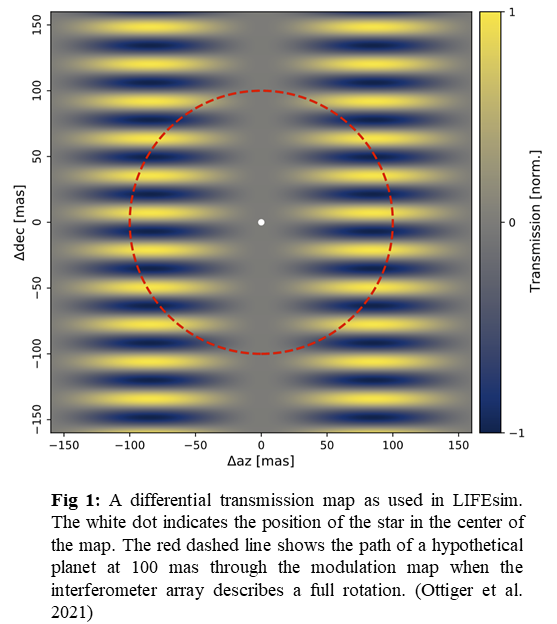LIFEsim: Methods for predicting the capability of the future LIFE mission
- 1ETH Zurich, Institute for Particle Physics & Astrophysics, Wolfgang-Pauli-Str. 27, 8093 Zurich, Switzerland
- 2National Center of Competence in Research (NCCR) PlanetS, Switzerland
- 3Space Telescope Science Institute, Baltimore, MD 21218, USA
- *A full list of authors appears at the end of the abstract
Context
The Large Interferometer for Exoplanets (LIFE) is a proposed future space mission enabling mid-infrared direct imaging observations of a large number of temperate terrestrial exoplanets. LIFE will be developed to answer a specific set of science objectives1 concerning the atmospheres and habitability of exoplanets. To have a successful mission, it is vital that these scientific requirements are sufficiently well translated into technical requirements based on which the instrument can be designed. Similarly, technical constraints might impact the scientific capabilities of the mission.
LIFEsim2 is a custom-built science simulator software for LIFE which aids in exactly this communication between the scientific and technical aspects of the mission design.
Aim
We aim to present the simulation pipeline as well as the technical and physical assumptions used in the current generation of the LIFE simulator. In its current development state, LIFEsim is capable of simulating nulling interferometric spectral observations of single targets accounting for all relevant astrophysical noise terms as well as predicting the total number and properties of exoplanet detections expected given a pre-defined optimization strategy (e.g., maximizing the yield of Earth-like exoplanets).
Simulator Pipeline
Artificial Planet Population
LIFE will discover many planets in a radius and insolation parameter space which is inaccessible by current instruments. To correctly predict the number of detections in this region of parameter space, it is necessary to create a sample of artificial exoplanets. We start with a star catalog containing real single and wide (>20 au) binary main-sequence stars within the next 20 pc. These stars are then populated with synthetic exoplanets based on occurrence rates from the Kepler mission. This step is facilitated using P-Pop (Kammerer et al., 2018). In a Monte-Carlo approach, we simulate 500 different universes.
Instrument Simulation
A nulling interferometer aims to achieve two goals. It blocks the light of the central star by placing it in a destructive interferometric fringe and, by rotation of the instrument, it dissociates between symmetric and asymmetric signals around the star. To simulate this behaviour, we calculate the interferometric fringe pattern (the transmission map, see Figure 1) of a double Bracewell interferometer capturing the response of the instrument to on-sky signals (Ottiger et al., 2021).

Noise Sources
Several astrophysical noise sources complicate the detection of exoplanets with LIFE. The non-zero apparent extend of the host star contributes photons under the sinusoidal shape of the transmission map. Zodiacal dust in the target system extends even further out from the star. It is heated by the star and therefore contributes to the measurement at wavelengths similar to the thermal emission of terrestrial exoplanets. Lastly, because LIFE will be located at the Earth-Sun L2-point, targets have to be viewed through the thermal emission of the local-zodiacal dust cloud in the solar system. These noise contributions are modeled and propagated in LIFEsim. In the current state, LIFEsim does not account for instrumental noise. This implies that the current simulations treat LIFE as operating in the background-limited case. While the goal for LIFE is to operate in this regime, future work will aim to include instrumental noise effects in the simulation.
Observation Time Optimization
The LIFE mission will allocate a specific amount of time (2.5 yrs) to the detection of previously unknown exoplanets. This time needs to be distributed among the star systems. We present observing sequences optimized for either the maximum number of detected exoplanets or for the maximum number of detected terrestrial exoplanets which reside in the empirical habitable zone (Kaltenegger, 2017) of their respective host star. Improving on Lawson et al. (2007), we present an optimization method in which the systems are ranked according to their efficiency measured in number of detected planets per observation time spend on the system. Additionally, we present a trade-off between the total number of observed exoplanets and the completeness to which the individual systems are observed using a method suggested in Stark et al. (2014).
Results
We report that LIFEsim is able to simulate exoplanet detection yields and single spectral observations for the LIFE mission in the background limited case.
The scientific implications of the predicted exoplanet yield (Kammerer et al. 2021, this conference) and the spectral retrieval of planetary atmospheres (Alei et al. 2021, Konrad et al. 2021, this conference) are discussed in separate talk submissions to this conference.
____________________
1 https://www.life-space-mission.com/the-project/science/
2 The LIFEsim tool is publicly available at https://github.com/fdannert/LIFEsim
References
Kammerer, Jens, and Quanz, Sascha P. : "Simulating the Exoplanet Yield of a Space-Based Mid-Infrared Interferometer Based on Kepler Statistics", Astronomy and Astrophysics, vol. 609, 2018
Ottiger, Maurice, et al. : "Large Interferometer For Exoplanets(LIFE):II. Signal simulation, signal extraction and fundamental exoplanet parameters from single epoch observations", 2021 (in prep.)
Kaltenegger, Lisa. "How to Characterize Habitable Worlds and Signs of Life." Annual Review of Astronomy and Astrophysics, vol. 55, 2017
Lawson, P. R., et al. "Terrestrial Planet Finder Interferometer: 2006-2007 Progress and Plans." Techniques and Instrumentation for Detection of Exoplanets III, vol. 6693, March, 2007
Stark, Christopher C., et al. "Maximizing the ExoEarth Candidate Yield from a Future Direct Imaging Mission." Astrophysical Journal, vol. 795, no. 2, 2014
https://www.life-space-mission.com/
How to cite: Dannert, F., Kammerer, J., Angerhausen, D., and Quanz, S. P. and the LIFE collaboration: LIFEsim: Methods for predicting the capability of the future LIFE mission, European Planetary Science Congress 2021, online, 13–24 Sep 2021, EPSC2021-326, https://doi.org/10.5194/epsc2021-326, 2021.

